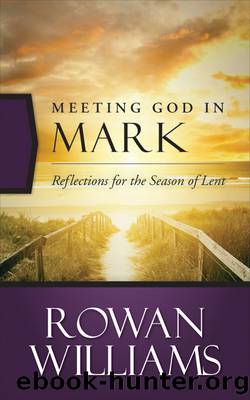Meeting God in Mark: Reflections for the Season of Lent by Rowan Williams

Author:Rowan Williams
Language: eng
Format: epub
ISBN: 9781611645613
Publisher: Westminster John Knox Press
Published: 2014-09-15T00:00:00+00:00
3
A lifelong passion
About one-third of St Markâs Gospel is taken up with the events of the last week of Jesusâ life, the story of Jesusâ betrayal, suffering and death, his âPassionâ. Itâs a very striking proportion, which has led some scholars to describe St Mark as a Passion narrative with a long introduction (by way of comparison, only about one-seventh of the Gospels of Matthew and Luke are taken up with the narrative of Jesusâ last days before the crucifixion). And in Mark itâs made very clear that, as we move into this section, weâre moving into a slightly different atmosphere. A narrative which up to this point has felt quite rushed and packed, even a bit scattergun in its effect, noticeably slows down. There are far more quotations from the Old Testament; and, intriguingly, far more references to specific places in and around Jerusalem. There is careful reference to the time of day when things happened.
What makes this interesting is that many readers have observed how slapdash Markâs geography can appear in the rest of the Gospel. He seems, for example, to be confused as to whether Tyre is north or south of Sidon â though, as one recent commentator remarked, if we were asked unprepared whether Manchester was north or south of Liverpool, a lot of us might have similar problems⦠But in contrast to this general aspect of his narrative, thereâs no doubt at all that when Mark turns to this final period, he has a very specific set of locations in mind. If you read the last couple of chapters carefully, youâll notice that they divide clearly into episodes at particular places: the upstairs room where the Last Supper takes place; the garden on the Mount of Olives; the High Priestâs house; the Roman governorâs residence; the path to Golgotha, âthe place of the skullâ, where the executions are performed; and the tomb. And this has suggested to some readers a theory which has a good deal of persuasive force, to the effect that the kernel of this narrative began as a kind of liturgy in Jerusalem6 â something a little like the Stations of the Cross in the later Church. Thatâs to say, these are texts distilled from the experience of early Christians walking reflectively in the footsteps of Jesus in his own city. At each geographical point in the city, each âstationâ, at specific times of day, there would be a narrative with some Old Testament quotations to show that these events had been foreseen in the divine plan, and then perhaps some prayers, concluding at the tomb with the announcement that âHe is not here, he is risen.â
This makes very good sense of the way in which the story is told; and it gives a very firm basis to the idea that Mark, along with Matthew and Luke, and John too for that matter, is here depending not just on the narratives passed down from the earliest community, but on a practice of
Download
This site does not store any files on its server. We only index and link to content provided by other sites. Please contact the content providers to delete copyright contents if any and email us, we'll remove relevant links or contents immediately.
| Catechisms | Devotionals |
| Hymns & Hymnals | Meditations |
| Monasticism & Asceticism | Pentecostal & Charismatic |
| Prayerbooks | Rites & Ceremonies |
| Sacraments |
Fangirl by Rainbow Rowell(7856)
How to Bang a Billionaire by Alexis Hall(7427)
Wonder by R. J. Palacio(7094)
The Space Between by Michelle L. Teichman(6105)
The Thirst by Nesbo Jo(5810)
Assassin’s Fate by Robin Hobb(5265)
Wiseguy by Nicholas Pileggi(4616)
The Kite Runner by Khaled Hosseini(4493)
The Night Circus by Erin Morgenstern(4447)
Bittersweet (True North #1) by Sarina Bowen(4348)
Paper Towns by Green John(4183)
Gerald's Game by Stephen King(3937)
Too Much and Not the Mood by Durga Chew-Bose(3705)
Pillow Thoughts by Courtney Peppernell(3434)
Twelve Days of Christmas by Debbie Macomber(3034)
Goodbye Paradise(2989)
Good by S. Walden(2927)
The Rosie Effect by Graeme Simsion(2723)
After We Fell by Anna Todd(2662)
